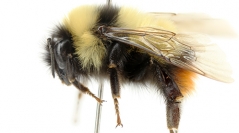Abstract. Species are often presumed to be apparent in nature, but in practice they may be difficult to recognise, especially when viewed across continents rather than within a single site. Coalescent-based Poisson-tree-process (PTP) models applied to fast-evolving genes promise one quantitative criterion for recognising species, complete with the estimates of uncertainty that are required of a scientific method. Such methods face challenges especially in discerning between widespread polytypic species and complexes of closely related, restricted-range species. In particular, ‘over-sampling’ of many closely related individuals within one species could risk causing groups of less closely-related individuals within other species appearing relatively more distinct and consequently could risk them being interpreted falsely as separate species. Some of the most persistent taxonomic problems among bumblebees (genus Bombus Latreille, 1802) are within the subgenus Melanobombus von Dalla Torre, 1880. For a global revision of Melanobombus species, we use COI barcodes and seek to reduce the risk from localised over-sampling by filtering the data to include only unique haplotypes. Unique haplotypes give more conservative results than unfiltered data, but still increase the number of species in comparison with recent morphological treatments. After integrative assessment of COI coalescents in comparison with morphological groups, the number of accepted species shows a non-linear increase with sample size that plateaus to an increase of 47% (to 25 species) compared with a previous estimate (of 17) based on morphology alone. For the most widespread and variable species-complexes, our revised species improve the match to the patterns expected of species, both for genetic divergence-with-distance and for sympatry, leading to three main inferences. (1) The particularly widespread polytypic Bombus sichelii Radoszkowski, 1859, is a single species. (2) We detect two candidates for species within previous broad concepts of each of the former B. lapidarius (Linnaeus, 1758), B. miniatus Bingham, 1897, and B. rufofasciatus Smith, 1852. Within B. lapidarius s. lat. we find insufficient evidence to corroborate the candidate species, with no coalescent or morphological support for a recent claim for a separate species, B. bisiculus Lecocq, Biella, Martinet & Rasmont, 2019 described from southern Italy, but rather we find a weak and uncorroborated coalescent for a different and much broader group of samples from across southeastern Europe but excluding Turkey. Within the former broad concepts of B. miniatus s. lat. and B. rufofasciatus s. lat. the coalescent evidence is stronger and subtle evidence from morphology corroborates recognising B. miniatus s. str. and B. eurythorax Wang, 1892 stat. rev. as separate species as well as B. rufofasciatus s. str. and B. prshewalskyi Morawitz, 1880 stat. rev. as separate species. (3) Our coalescent and morphological results ‘split’ more clearly what has long been interpreted as a single polytypic B. keriensis Morawitz, 1887, s. lat., by supporting novel concepts of the restricted-range species: B. alagesianus Reinig, 1930 stat. rev., B. incertoides Vogt, 1911 stat. rev., B. keriensis s. str., B. qilianensis sp. nov., B. separandus Vogt, 1909 stat. rev., and B. tibeticus sp. nov. A lectotype is designated for the name B. keriensis and a neotype is designated for the name B. alagesianus. We estimate the phylogeny of Melanobombus species by including three slower-evolving genes to provide more evidence for deeper relationships, to estimate the time calibration of this phylogeny, and to estimate ancestral distributions, all within a Bayesian framework. We provide the first keys for identifying all of the species of Melanobombus.


 European Journal of Taxonomy
719 (1) - Pages 1-120
European Journal of Taxonomy
719 (1) - Pages 1-120